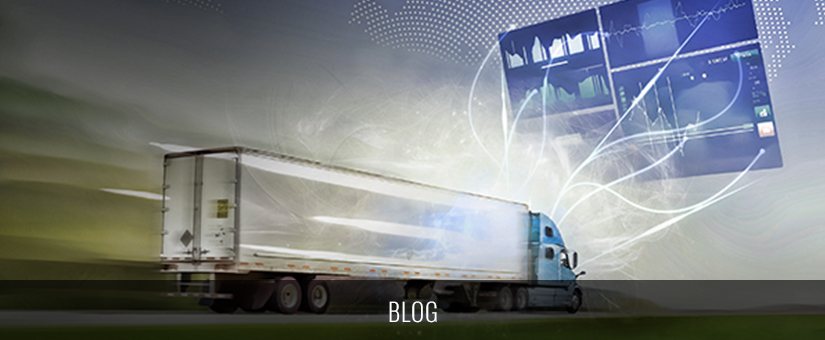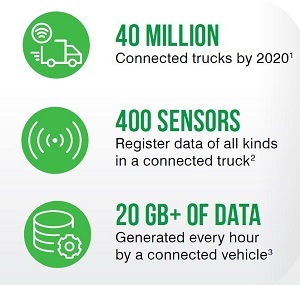
Unlocking the Full Potential of Connected Trucks through Analytics
By Takin Babei, Product Marketing Director, SmartDrive Systems
Manufacturers of commercial trucks are equipping their vehicles with smart sensors, telematics platforms, advanced driver assistance systems (ADAS) and connectivity technology to help their customers reduce maintenance costs, boost productivity and improve driver safety. Frost  & Sullivan’s Commercial Vehicle Telematics Group (CVTG) estimates by 2020 there will be more than 40 million connected trucks on the road. Already today, Daimler Trucks generates valuable information to a previously unimaginable extent with approximately 400 sensors per vehicle and fully connected software – including 100 million lines of code (more than a passenger jet!).
& Sullivan’s Commercial Vehicle Telematics Group (CVTG) estimates by 2020 there will be more than 40 million connected trucks on the road. Already today, Daimler Trucks generates valuable information to a previously unimaginable extent with approximately 400 sensors per vehicle and fully connected software – including 100 million lines of code (more than a passenger jet!).
Connected trucks have the potential to radically change how fleet managers run their business and manage their vehicles in the coming years. How? According to Frost & Sullivan’s CVTG, fuel, driver wages, maintenance and tires – together – comprise approximately 62% of the total cost of fleet operations. The data generated by a connected truck can play a critical role in helping fleets reduce risk, decrease waste and drive down churn, while also exploring opportunities for innovation.
Overwhelmed by Data?
The amount of information available to fleets today can seem overwhelming. It is estimated that 20GB+ of data is generated every hour by a connected vehicle. However, most fleets are in no position to draw insights from it.

Instead of overwhelming your teams, it’s important to have a solution that transforms huge amounts of driving events and vehicle data into actionable analytics to help you answer the following types of questions:
- How long are my drivers on the road? How fast are they going? How much fuel are they consuming?
- How much money are we spending on idling fuel expense at my company or my site?
- Who are my riskiest new drivers? What risky behaviors are affecting their safety score? Are my coaching sessions improving performance?
- Which drivers are likely speeding up wear and tear on my vehicles and how can I ensure specific behaviors that lead to maintenance costs (like hard braking and fast acceleration) improve over time?
Getting answers to above-mentioned, or similar questions, enables fleet managers to improve driver safety and reduce cost. For example, using SmartDrive SmartIQ® analytics, Nussbaum Transportation created an innovative driver-performance program that scores drivers on smooth driving, speed management, space management and throttle usage using real-time data from the engine control module (ECM) and following-distance observations. With this knowledge, drivers are rewarded, or coached, as needed. As a result, Nussbaum has improved its CSA BASIC score by nearly 73% in the “crash indicator” category and its score in the “unsafe driving” category is the lowest it has been in two years. In addition, the company reported zero preventable DOT-recordable accidents, jackknifes and major loss-of-control accidents within the first six months of implementation.
We are living in the era of big data and analytics, and those unable to adopt these technologies and services will be missing out on the future of transportation and its impact on their fleet. Take a look at this transportation intelligence infographic and learn how to unlock the full potential of your data through actionable analytics.
Takin Babaei is the analytics product marketing director at SmartDrive Systems, with 10+ years of product marketing experience in business analytics with companies that include BusinessObjects, SAP and Oracle. His career has focused on bringing differentiated products to market and providing the “compelling reason to purchase” for customers and prospects alike. His areas of expertise include analytic applications, IoT, big data analytics, cloud computing, digital marketing, PaaS, SaaS and social media. Takin holds a B.S in Computer Science with a minor in Marketing from San Diego State University.
- Posted by Melissa.Senoff@smartdrive.net
- On 18 December 2017